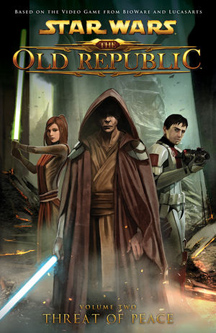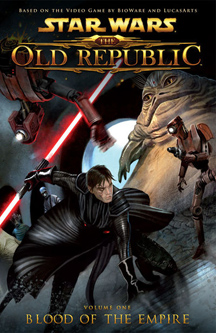There are two ways to approach video game tie-in comics – in a way that appeals to comic book fans, or in a way that appeals to players of the game. The “Knights of the Old Republic” game (2003) used the former approach, as John Jackson Miller told a coherent and engaging 55-issue serial, with the game’s Republic versus Mandalorians war as the backdrop. “The Old Republic” game — which launched in 2011 and is still going strong, and which followed “Knights” on the “Star Wars” timeline – used comics to flesh out specific events of the Republic versus Sith Empire war rather than telling an ongoing narrative.
For people unfamiliar with the game, these stories give us little reason to care about what is happening – particularly the two “Old Republic” webcomic series (2010), which were collected in print form as “Volume One: Blood of the Empire” (Issues 28-39 of the webcomic) and “Volume Two: Threat of Peace” (1-27). In fact, the whole rollout of “The Old Republic’s” ancillary materials was messy: Like the comic stories, the four novels were not released in the order they occur on the timeline. Despite being in the media of books and comics, the target audience is primarily gamers – sort of like the short stories in West End Games’ roleplaying game manuals from the 1980s and ’90s.
But I’m a “Star Wars” comics completist, so here goes: Of the two webcomic arcs, Alexander Freed’s “Blood of the Empire,” set during the early part of the three-decade war, is the more tolerable entry. During this time, the Sith Empire runs an academy on Korriban, much as it would do two millennia later during the “Darth Bane” trilogy. One student, the male human Teneb Kel (eventually Darth Thanaton), is assigned to track down and kill the Sith Emperor’s apprentice, the female Sith/human hybrid Exal Kressh, because she has fled with a secret.
The secret is that the Emperor has set up an alchemy-driven equivalent of the prequel’s Kamino cloning facility – or Emperor Palpatine’s lab featuring clones of himself in “Dark Empire” — to produce an unlimited supply of dark-side warriors. Kel kills Kressh for the secret, then parlays his knowledge into a cushy post within the Dark Council.
Thanaton is your basic self-centered Sith. His relationship with his slave-turned-sidekick Maggot is the most interesting part of the story, because it’s unclear if he is appreciative of Maggot or sees him as a disposable underling; this is largely due to the Abyssin’s extremely unfortunate name.
We don’t learn anything about how the Sith – or the emperor himself — have built up enough power to make war with the Republic. The Sith were vanquished during the events of the “Tales of the Jedi” series, then rumored to be making a return throughout “Knights” (Zayne Carrick was wrongly accused of being a Sith), although it never happens.

Rob Chestney’s “Threat of Peace” jumps ahead 25 years and chronicles the Treaty of Coruscant, which as far as I can tell signifies the official end of the war, although the treaty will have reverberations leading to future “Old Republic” stories. It’s an extremely choppy read with bad art, but I gather that the Sith manipulate the Republic into the signing the treaty, and many members of the Republic aren’t too thrilled about it.

“Threat of Peace” introduces the teenage human Satele Shan, who will go on to become the Jedi Order’s Grand Master. Wookieepedia tells me she’s the daughter of Bastila Shan, a character from the “Knights” game (but not the comic). Satele also appears in three of the four “Old Republic” books and factors into the only non-web comic volume, “The Lost Suns.” Satele is the closest we get to a main character in “The Old Republic.”
The back of the “Threat of Peace” trade paperback includes a guide to characters, organizations and locations during the Sith versus Republic war. It’s the best part of the collection. But “The Lost Suns” picks up a few decades later, so the comic series doesn’t build on Chestney’s groundwork. The guide – like the webcomics themselves – seems to be for gamers looking to better understand the environment.

